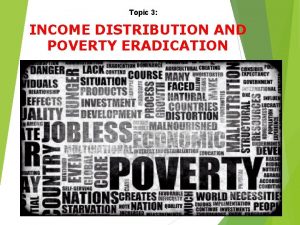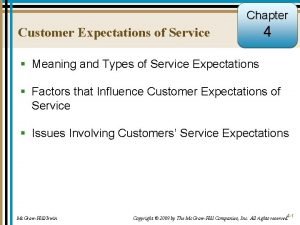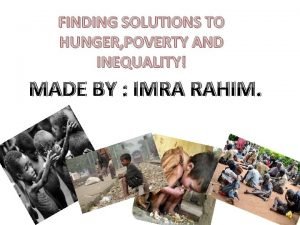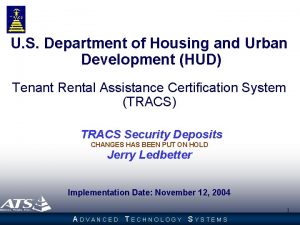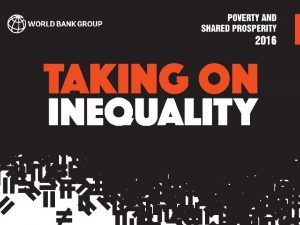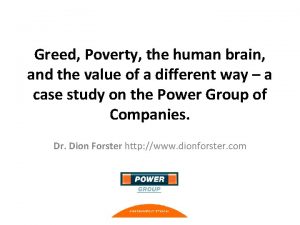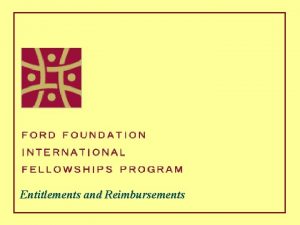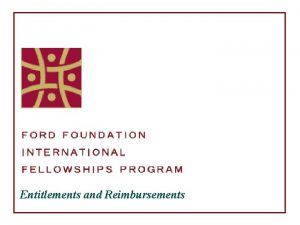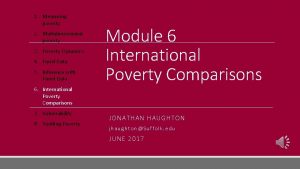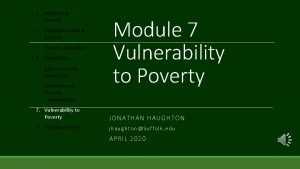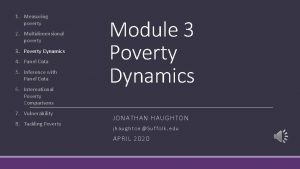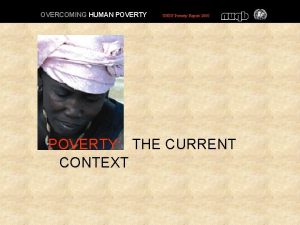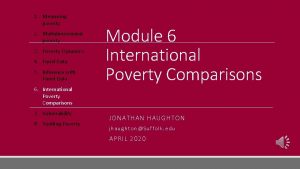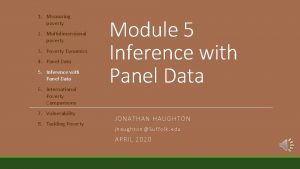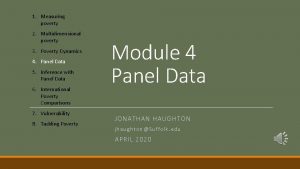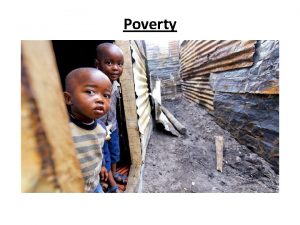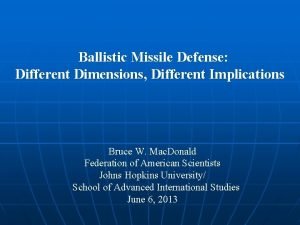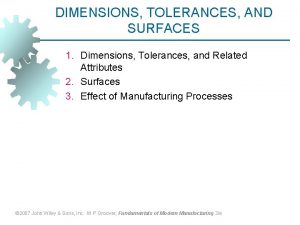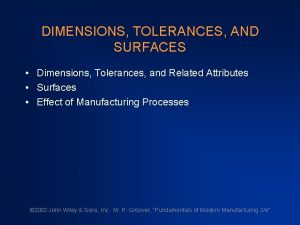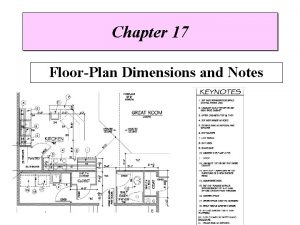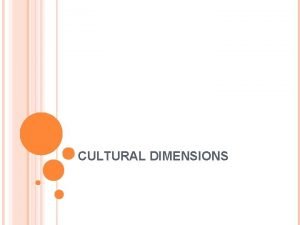Session 3 Different Dimensions of Poverty Entitlements and


















- Slides: 18

Session 3: Different Dimensions of Poverty Entitlements and Ownership • Ownership relations are one kind of entitlement relations -ownership connects one set of ownership to another through certain rules of legitimacy. • Chain of entitlements legitimizes the one set of ownership by reference to another or to some basic entitlement in the form of fruits of other’s labor.

Session 3: Different Dimensions of Poverty Different types of Entitlement • Trade based entitlement • Production based entitlement • Own labor entitlement • Inheritance and transfer entitlement

Session 3: Different Dimensions of Poverty Exchange Entitlement • Set of alternative bundles of commodities that can be acquired in exchange which give the ownership is called exchange entitlement. • Exchange entitlement mapping is the relation that specifies the set of exchange entitlements for each ownership bundle -E-mapping defines the possibilities that would be open to him corresponding to each ownership situation.

Session 3: Different Dimensions of Poverty Determinants of exchange entitlement • Employment and wage rate. Time period fir wage employment • Earning from the selling non-labor assets and cost of buying new commodities • Production of labor power and other resources • Cost of production and revenue generated from this production • Social security benefits entitlement and taxes paid.

Session 3: Different Dimensions of Poverty • Exchange entitlement and ownership depend on the person’s position in the economic class structure as well as modes of production -example of Share Cropper and Agricultural Laborers. • In absence of social security and employment, exchange entitlement is not adequate to remove starvation

Session 3: Different Dimensions of Poverty Concepts of Poverty • 1 st query: -is it related to only poor or only non-poor or the both? -1 st concept does not imply any denial of the fact that suffering of the poor may depend on the condition of the non-poor - causation of poverty and effects of poverty are important to study.

Session 3: Different Dimensions of Poverty Drawbacks of Head Count Ratio as a measurement of Poverty • It does not take any account of the extent of the shortfall of incomes of the poor from the poverty line -with any reduction of the income of the rich, H ratio remains unchanged • It is insensitive to the income distribution among the poor.

Session 3: Different Dimensions of Poverty Concept of Poverty • It includes a method of identifying a group of people as poor • A method of aggregating the characteristics of the set of poor people into an overall image of poverty

Session 3: Different Dimensions of Poverty Different Approaches of Poverty • The Biological Approach -if their total earnings are insufficient to obtain the minimum necessities for the maintenance of physical efficiency -survival or work efficiency defines the poverty line • Criticism of this approach: -minimum nutritional requirement is varied -translation of minimum nutritional requirement into minimum food requirement is problematic -for non-food items minimum requirement is difficult to specify.

Session 3: Different Dimensions of Poverty What we can take • There is little vagueness among the concepts of nutrition and poverty. The issue is whether this vagueness is of required kind. • Identification of poverty and nutritional status need not go through the intermediary of income at all. • Proximity of actual habits and behavior makes it possible to derive income levels at which the nutritional norms will be met • Malnutrition must have a central place in the conception of poverty.

Session 3: Different Dimensions of Poverty • The Inequality Approach: -concept of poverty is essentially one of inequality has some immediate plausibility -we move away from efforts to measure poverty lines with pseudo scientific accuracy. • Criticism: -Poverty ad inequality are associated concepts but to analyze poverty as an issue of inequality would do little justice to either.

Session 3: Different Dimensions of Poverty • Relative Deprivation -sociological aspect of poverty -concept of deprivation is relative in nature. • There is a distinct and different notions in this concept -feelings of deprivation vs. conditions of deprivation • One can use this concept objectively to describe the situation in terms of income, favorable employment, power etc.

Session 3: Different Dimensions of Poverty • Another view is that conditions of deprivation also depends on the feelings of deprivation. • An objective understanding of conditions requires an objective understanding of feelings • Role of power in this context • It cannot be the sole approach of poverty.

Session 3: Different Dimensions of Poverty • Value Judgement: -Poverty is something that is disapprove of – Its elimination is regarded as morally good Arguments against this perspectives: – The conventions of society are matters of fact and not issues of morality or of subjective search. – Smith's view: example of linen shirt and leather shoes – Marx's view average quantity of the means of subsistence necessary for the labor is practically known.

Session 3: Different Dimensions of Poverty • Smith and Marx overestimated about the uniformity of views that tends to exist in a community on poverty and subsistence • Need descriptive approach of poverty rather than the prescriptive one.

Session 3: Different Dimensions of Poverty • Policy Definition: -it reflects a balancing of community capabilities and desire – One society thinks it is difficult to worry much beyond physical survival while other societies are able to support their dependent citizens more than survival. – It fails to capture the political issues in policy making – It should depend on assessment of feasibilities

Session 3: Different Dimensions of Poverty Standards and Aggregation Standards vary from society to society common standards and respective standards Identification of poor requires common standard however aggregation requires some method of combining deprivations of different people into some overall indicator arbitrariness of aggregate description becomes tempting to redefine problem as an ethical exercise. But it also involves similar ambiguity.

Session 3: Different Dimensions of Poverty As a Whole Poverty and Inequality relate closely Poverty is a matter of deprivation Biological approach deserves substantial attention and reformulation Measurement of poverty should be descriptive not judgemental.
 Relative and absolute poverty
Relative and absolute poverty Prsi dental entitlements
Prsi dental entitlements License entitlements
License entitlements Matrix multiplication associative property
Matrix multiplication associative property What are the two types of people media?
What are the two types of people media? Lasting service intensifiers
Lasting service intensifiers Possible levels of customer expectations
Possible levels of customer expectations Dual customer expectation levels
Dual customer expectation levels Relative and absolute poverty
Relative and absolute poverty Poverty and juvenile delinquency
Poverty and juvenile delinquency Esperanza’s house symbolizes poverty and
Esperanza’s house symbolizes poverty and St john chrysostom on wealth and poverty pdf
St john chrysostom on wealth and poverty pdf Poverty and hunger solutions
Poverty and hunger solutions Symbolic interactionist perspective on poverty
Symbolic interactionist perspective on poverty Hudco full form
Hudco full form Inequality and poverty
Inequality and poverty Greed and poverty
Greed and poverty Why do different polymers have different properties
Why do different polymers have different properties Technicolor test
Technicolor test
